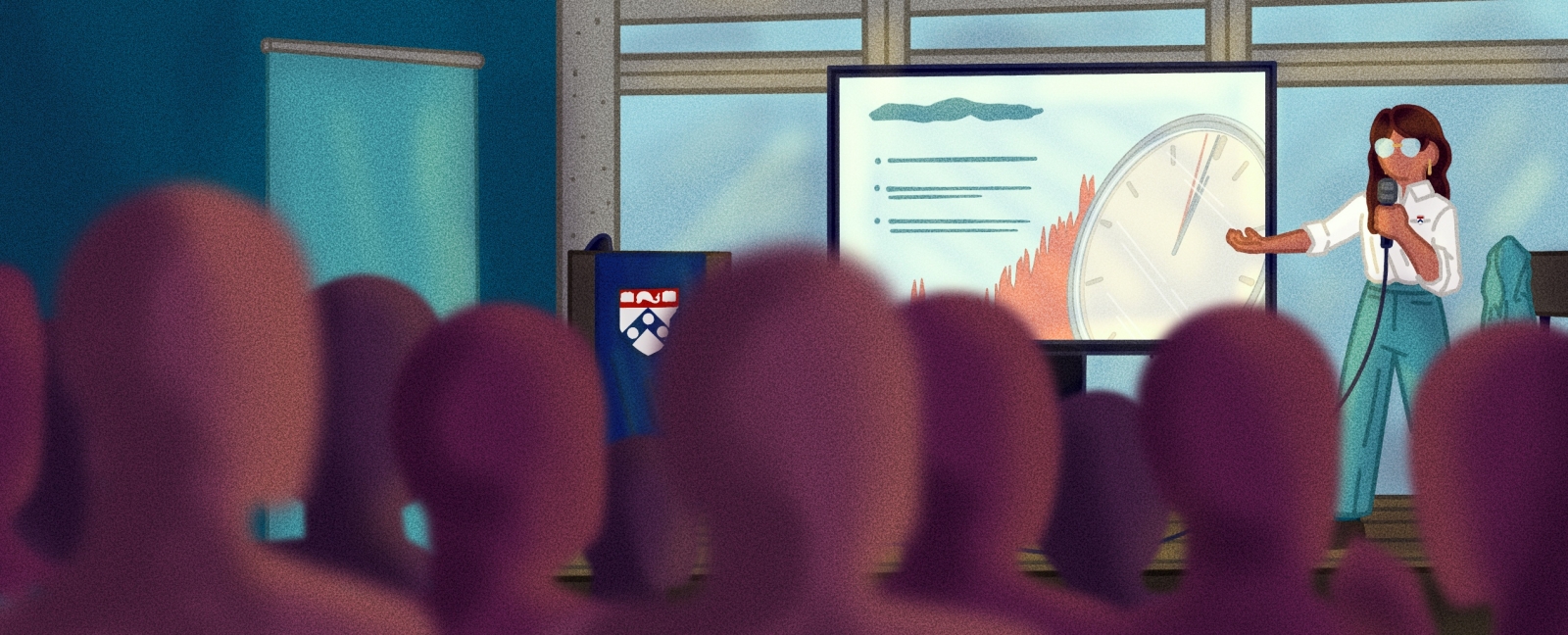Through the lens of time, humans represent little more than a passing shadow, present for a fraction of a percent of our planet’s 4.5-billion-year history, and even now, with a population of more than 8 billion, encompassing less than 0.01 percent of life on Earth. Despite this, humanity has emerged as a force, rapidly altering ecosystems, reducing biodiversity, warming the atmosphere and oceans, and changing the fundamental equilibrium that has defined and supported life throughout our geologic era.
In this moment, with the hottest summer on record—again—Penn Arts & Sciences faculty are responding to the climate emergency. They’re assessing the challenges and generating solutions, thinking creatively about the policymaking that must follow and considering how best to communicate this complicated and often-controversial issue.
“Problems of this complexity require breadth in approach,” says Mark Trodden, Associate Dean for Natural Sciences and Fay R. and Eugene L. Langberg Professor of Physics. “Here, Penn Arts & Sciences is positioned to lead, from the basic science through the development of new technologies, formulating and communicating options for the public and policymakers.”

Assessing the Problem
Coral Reefs
Nearly a quarter of fish in the ocean depend on healthy coral reefs. So do a billion people worldwide. But the coral are suffering as warmer water temperatures lead to mass bleaching events. Katie Barott, Associate Professor of Biology, is studying these ecosystems to understand just how climate change is distressing the coral and reefs, from the cells to the whole organism.
Glaciers
Icy glacial melt provides an important water source for communities and ecosystems worldwide, yet glaciers have been shrinking for decades, by some estimates since the 1950s. Through fieldwork in Greenland and elsewhere, Jon Hawkings, Assistant Professor of Earth and Environmental Science, is trying to understand the effect rapid environmental changes have on glaciers, meltwater, and ecosystems downstream. Leigh Stearns, Professor of Earth and Environmental Science, also works in this space, studying ice sheet dynamics and sea-level rise, as well as shifts in iceberg and sea-ice distributions.
Arctic Sea Ice
Arctic temperatures are rising quickly, a trend closely linked to a multi-decade Arctic sea ice loss. The decline of the ice serves as both a clear indicator of ongoing climate change and a driver of what might happen in the future. But when might Arctic sea ice disappear altogether? According to statistical forecasting models from economist Francis X. Diebold, Paul F. Miller, Jr. and E. Warren Shafer Miller Professor of Social Sciences, nearly ice-free Arctic Septembers are likely before 2040.
Vector-Borne Disease
Black-legged ticks—the ones that transmit Lyme disease—thrive in warmer, humid climes, so higher temperatures equate to more suitable habitat. To forecast where future disease hotspots might arise, Biology Professor Dustin Brisson, Tammy Tran, GR’21, and William Manley, C’20 (now a Penn graduate student), created a model that successfully predicts prevalence and distribution of Borrelia burgdorferi, the bacteria that cause Lyme disease.
Local Impact
In November, the University released its latest Climate & Sustainability Action Plan, with input from Jared Farmer, Walter H. Annenberg Professor of History, Anne Berg, Assistant Professor of History, and Kristina Lyons, Associate Professor of Anthropology, who were all part of the Environmental Sustainability Advisory Committee. They worked on transportation, strategic waste, and civic engagement and outreach, respectively.
Climate Change and Children
The Climate, Environment, and Childhood Inequality initiative, co-led by Emily Hannum, Associate Dean for Social Sciences and Stanley I. Sheerr Term Professor, Jere Behrman, William R. Kenan, Jr. Professor of Economics, and Fan Wang, GR’15, of the University of Houston, focuses on how climate change affects the health and well-being of children in China, India, and a number of other low- and middle-income countries.

Thinking Creatively about Policy
Solar Acceptance
New solar projects often face community opposition, and Parrish Bergquist, Assistant Professor of Political Science; the Kleinman Center for Energy Policy’s Sanya Carley; and Alison Knasin, GR’23, have a plan to better understand why. In Department of Energy-funded work, they will follow 24 proposed solar projects, talking with and listening to the people the new infrastructure will most likely affect. They hope to show how better public engagement can improve solar project acceptance at the community level.
Global Reach
Since 2014, Michael Weisberg, Bess W. Heyman President’s Distinguished Professor of Philosophy, has led efforts in the Galápagos to understand human and climate-related impacts on this fragile ecosystem. More recently, Weisberg contributed to the Intergovernmental Panel on Climate Change’s Sixth Assessment and serves as a UN Climate Conference senior negotiator, where he helped foster a decision establishing new funding arrangements to address adverse climate impacts.
Climate and the Economy
Jesús Fernández-Villaverde, Howard Marks Presidential Professor of Economics, wanted to better understand how the climate affects the economy and vice versa. So, he and colleagues figured out how to integrate state-of-the-art climate science into standard economic models. The result—called a structural Integrated Assessment Model—can help design optimal policies such as the best tax approach to decarbonizing the economy.
Global Challenges
The two-year-old Penn Development Research Initiative-DevLab@Penn, co-led by Guy Grossman, David M. Knott Professor of Global Politics and International Relations, Erik Wibbels, Presidential Penn Compact Professor of Political Science, and Heather Huntington, Associate Professor of Practice, is working in 27 countries to help inform policy around forced displacement, land and environmental policies, and big-data analytics. (See more on p. 40.)
Water Policy
Faculty in departments from Anthropology to History and Sociology of Science are thinking about water. Nikhil Anand, Daniel Braun Silvers, W’98, WG’99 and Robert Peter Silvers, C’02 Family Presidential Associate Professor, for instance, has published extensively on the relation between water and society in Mumbai. His latest project coalesces around how fishers, scientists, and city planners imagine, design, and dwell in climate-changed cities in close proximity to the sea.

Generating Solutions
Plant Resilience
Through Plant ARC, a new initiative spearheaded by Doris Wagner, DiMaura Professor of Biology, six Department of Biology labs have come together under one umbrella. Their broad goal? To “climate-proof” plants and overcome adverse effects of climate change on food security and biodiversity. (See more on p. 4.)
Urban Water
Philadelphia, a city of 1.6 million people, faces aging water infrastructure and environmental threats to nearby freshwater sources. A team led by Howard Neukrug, Professor of Practice and director of Penn’s Water Center, is seeking local and global solutions that foster “resilient water management.” Neukrug is also chairing the Delaware River Basin Commission’s Advisory Committee on Climate Change, a group tasked with developing a climate resilience plan for the entire river basin.
Symbiotic Architecture
What if building materials could sequester carbon and remediate contaminated soil? That’s the goal of research led by Penn’s School of Design and involving Corlett Wood, Assistant Professor of Biology, and colleagues. They’re working to understand the ecological components of mycelium, a fungus being used to develop building material. Earth and Environmental Science Professor Reto Gieré is also part of the research.
Bird-Friendly Buildings
Thousands of birds migrating along the Atlantic Flyway—the corridor that runs up and down the East Coast of the United States—annually crash into buildings on Penn’s campus, unable to discern the structures that obscure their paths. During his junior year, Zade Dohman, C’25, worked with Penn Sustainability’s Bird-Friendly Penn initiative, recommending that campus buildings add to their windows a special type of film known to deter bird strikes.
Energy Innovations
Meeting the world’s current and future energy needs will require creative thinking and innovative, integrative basic research. That’s the aim of the Vagelos Institute for Energy Science and Technology, a collaboration between Penn Arts & Sciences and Penn Engineering, directed by Karen Goldberg, Vagelos Professor in Energy Research. Affiliated faculty are working on a range of complex issues, from energy storage to optimal use of natural gas and much more.
Solar Farms and Soil
Professor of Earth and Environmental Science Alain Plante and master’s student Hannah Winn sought to determine best management practices for soil health after installation of a solar farm. An extensive literature review revealed the need for monitoring and restoration practices. Next, an expanded team will try to determine the best starting point to compare pre-
and post-installation land conditions.

Communicating Clearly
Climate Risk Assessments
Irina Marinov, Associate Professor of Earth and Environmental Science, and several dozen collaborators across seven Penn schools created the open-source Global Climate Security Atlas. This data-visualization tool offers a straightforward way to assess risk for factors like heat and drought, precipitation, biodiversity, and more.
Community Engagement
This summer, Douglas Jerolmack, Professor of Earth and Environmental Science, and colleagues from the Netter Center for Community Partnerships and Penn Engineering, advised master’s students conducting community-engaged research with students from West Philadelphia’s Robeson High School. One project developed labs and curriculum material for a new Penn class about urban rivers; another generated a low-cost DIY flow meter to measure the speed of river water movement.
Effective Communication
Michael Mann, Vice Provost for Climate Science, Policy, and Action and Presidential Distinguished Professor in the Department of Earth and Environmental Science, has been at the forefront of climate communication for decades, beginning with his hockey-stick graph, the startling visual of the planet’s dramatic warming. Today, Mann continues his outreach throughthe Penn Center for Science, Sustainability, and the Media.
Instructive Art
Professor Poldergeist, aka Simon Richter, Class of 1965 Term Professor of German, is using animation and documentary film to shine a spotlight on what he describes as the cultural aspects of the climate emergency. His aim: to spread the word about climate adaptation and sea-level rise in the U.S., the Netherlands, Jakarta, and elsewhere.

At the highest levels, Penn Arts & Sciences has been working to address both the root causes of and fallouts from a changing climate, efforts on display in their entirety on a new website, climate.sas.upenn.edu.




